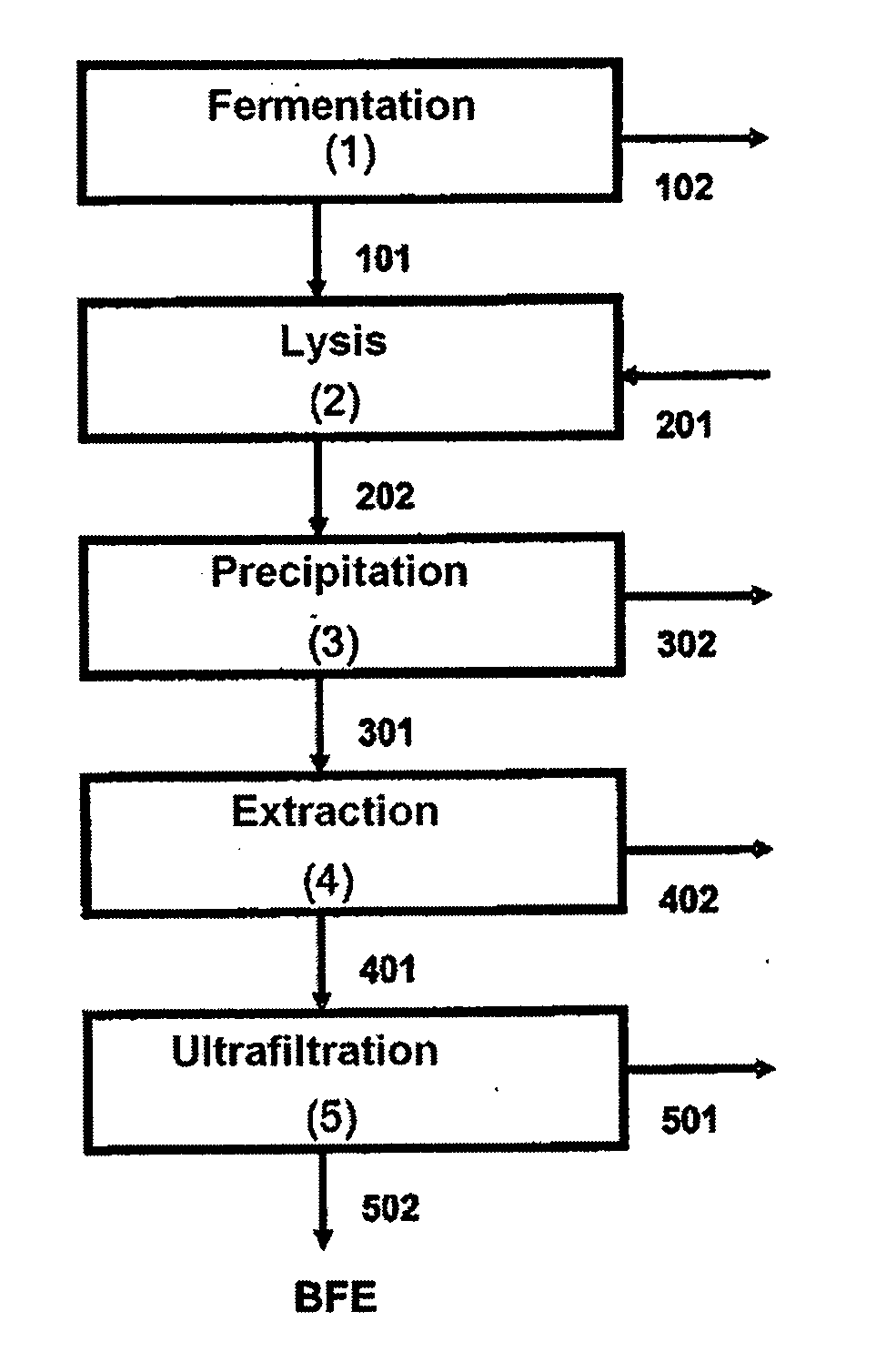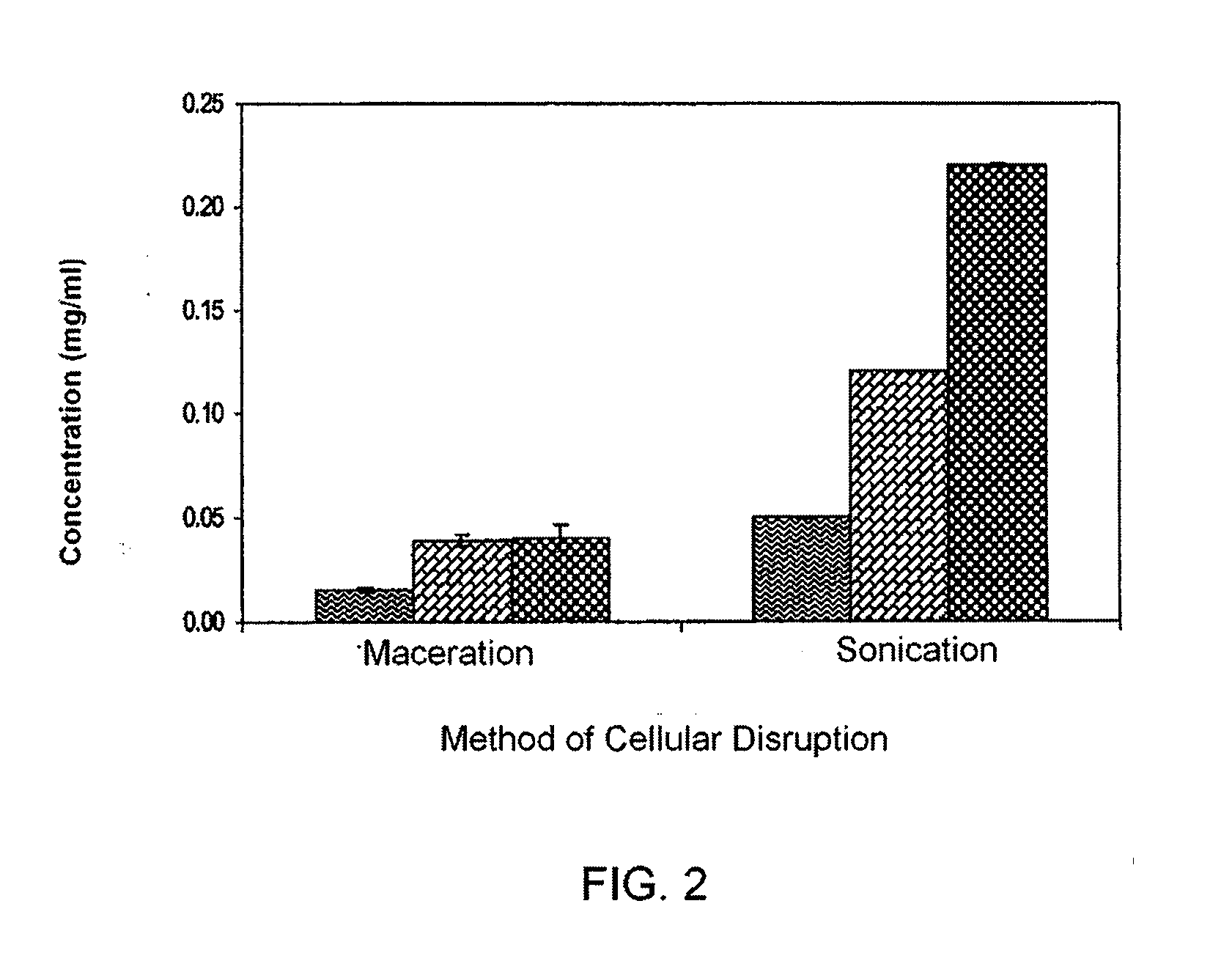Recovery and purification of b-phycoerythrin produced by porphyridium cruentum using two-aqueous-phase systems and isoelectric precipitation
a technology of porphyridium cruentum and bphycoerythrin, which is applied in the field of recovery and purification of bphycoerythrin produced by porphyridium cruentum using, can solve the problems of increasing the cost of production, reducing and burdening the use of artificial colorants
- Summary
- Abstract
- Description
- Claims
- Application Information
AI Technical Summary
Benefits of technology
Problems solved by technology
Method used
Image
Examples
example 1
Proposed Method of Recovery and Purification of BFE Produced by Porphypridium cruentum
[0028]With reference to FIG. 1, Porphyridium cruentum is cultured in a bioreactor (1) under conditions previously reported hereinabove. By centrifugation (1000 G, 5 min) the biomass (101) is separated from the spent culture medium (102). Distilled water in the amount of 4 cc per gram of wet biomass (201) used is added to the biomass, and the microalga is subjected to mechanical cellular disruption (2) by ultrasound exposure (10 min / g of wet biomass used). The pH of the homogenizate resulting from the cellular disruption (comprised of the protein of interest (BFE) and contaminants (including cellular residues)) is adjusted to 4 by addition of 1.0 N HCl to bring about isoelectric precipitation (3), at 10° C. To protect the sample from excessively long exposure to light at excessively high levels (>20 microeinstein per sq m per second) the container is covered with aluminum foil during the isoelectri...
example 2
Cellular Disruption to Liberate the Proteinaceous Colorant
[0029]With particular reference to FIG. 2, the intracellular proteinaceous colorants BFE, AFC, and RFC which are produced by Porphyridium cruentum (ATCC No. 50161) are liberated by cellular disruption by a manual technique (maceration) or by ultrasound exposure. The biomass produced by the culturing of Porphyridium cruentum (ATCC No. 50161) is recovered by centrifugation (5 G, 5 min). Cellular disruption by manual maceration is carried out in a ceramic mortar pre-cooled in an ice bath. The wet biomass is introduced to the mortar, and for each gram of biomass used 4 cc of double distilled water and 0.98 g glass granules are added. The time of maceration is determined based on the amount of biomass being processed, namely 15 minutes per gram. Cellular disruption using ultrasound is carried out with a “Branson 1510” ultrasound unit. Into a 50 cc glass tube, 5 g wet biomass is introduced, and 20 cc distilled water is added. The m...
example 3
Isoelectric Precipitation of the BFE Extract
[0030]50 cc crude BFE extract is prepared (with concentration 0.2 mg BFE / cc) and is separated into 1.5 cc aliquots in microcentrifuge tubes. The contents of the different tubes are adjusted to different pH values (1.5, 2.0, 2.5, 3.0, 3.5, 4.0, 4.5, 5.0, 5.5, 6.0, and 6.5), as a means of determining the pH at which isoelectric precipitation occurs. The pH adjustments are made using 0.1 N HCl. Each tube is agitated using an inversion mixer (60 rpm, 2 min), then is held at rest 10 min at 10° C. to allow agglomeration of the BFE. Then the mixture is centrifuged at 200 G 10 min. Following the centrifugation, the supernatant is removed by decantation. The precipitate is re-suspended in 1.5 cc phosphate buffer (20 mM, pH 7.0). For each pH value, the concentration and “purity” of BFE in the re-suspended crude extract are estimated (Abs 545 mm / 280 mm). It is found that the maximum “purity” of BFE in the re-suspended extract is obtained at pH 3.5-4....
PUM
| Property | Measurement | Unit |
|---|---|---|
| temperature | aaaaa | aaaaa |
| temperature | aaaaa | aaaaa |
| pH | aaaaa | aaaaa |
Abstract
Description
Claims
Application Information
 Login to View More
Login to View More - R&D
- Intellectual Property
- Life Sciences
- Materials
- Tech Scout
- Unparalleled Data Quality
- Higher Quality Content
- 60% Fewer Hallucinations
Browse by: Latest US Patents, China's latest patents, Technical Efficacy Thesaurus, Application Domain, Technology Topic, Popular Technical Reports.
© 2025 PatSnap. All rights reserved.Legal|Privacy policy|Modern Slavery Act Transparency Statement|Sitemap|About US| Contact US: help@patsnap.com



